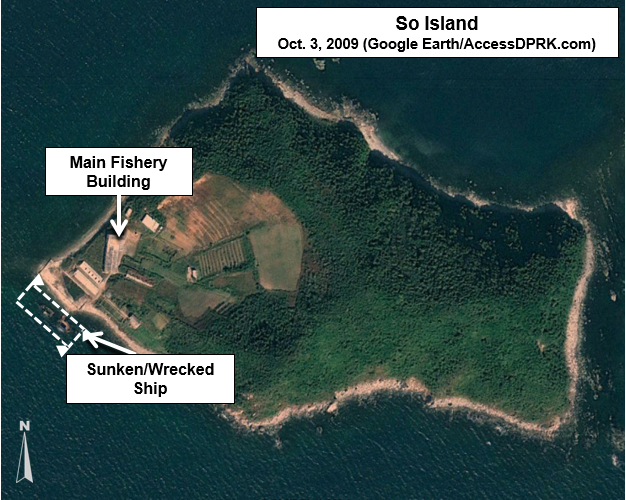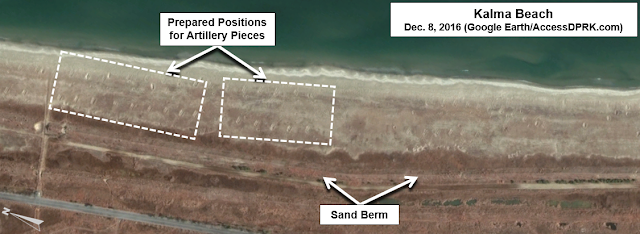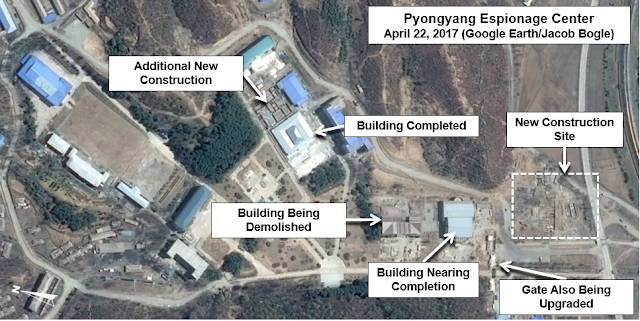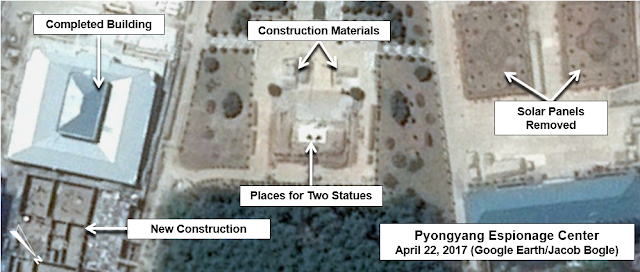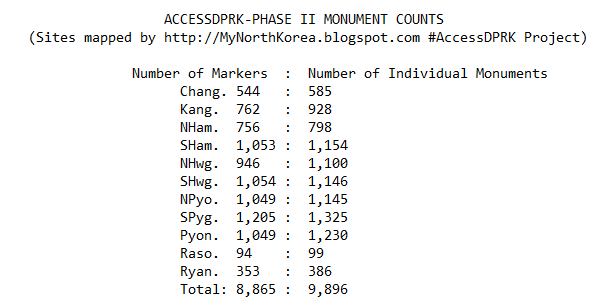(To save and read for later, you can download the PDF here)
Figure 1: Visitors bowing before statues of Kim Il-sung and Kim Jong-il at the Mansu Hill Grand Monument. (Image credit: Commons/J.A. de Roo)
Summary
While state-directed personality cults are nothing new, the magnitude of the North Korean personality cult surrounding the ruling Kim family surpasses any other. The cult’s main foundations are structured around the thoughts and orders of the Kims. Having a large effect on the nation’s economy, culture, and military, the cult and its associated “Kimilsungism-Kimjongilism” (the revolutionary political and philosophical thought of Kim Il-sung and Kim Jong-il) has been described as the primary focus of the country and a central motivation behind the activities of the government. [1][2]
The amount of resources dedicated to the construction, maintenance, and expansion of the cult over its decades of existence has cost the country billions in direct and indirect costs. The funding apparatus of this system features heavily within the bureaucratic hierarchies and helps to “grease the wheels” when it comes to providing assets for military programs and large construction projects; ostensibly to enable the construction of a “strong and prosperous nation”. In a country where one man rules with an iron grip and in which no major decision can be made without him, the use of the cult (and its mix of nepotism and bribery) is essential to Kim Jong-un’s ability to preserve his power and to direct resources to the parts of the economy he wishes to improve. However, the net effect of this has led to a byzantine system of kickbacks and inefficiencies that have hampered economic growth and progress as enormous efforts and monies are redirected away from the general economy to keep the system functioning.
History
The personality cult began soon after Kim Il-sung came to power in 1948. However, its intensity and the level of resources dedicated to it vastly expanded during Kim Jong-il’s rise to power as he elevated his father in an attempt to secure his own eventual succession as the unquestioned leader after his father’s eventual death in 1994 (after death he was then elevated to the position of Eternal President). Part of the cultural foundations of the cult that have allowed it to take root and survive for so many years, stem from Korea’s traditional imperial and Confucian past and its highly patriarchal nature.
Additionally, in light of Korea’s history of reliance on and subjugation by outside forces, the development of Juche in the early history of North Korea (in practice, a mix of self-reliance and nationalist racialism) makes more sense. In such a context, the invention of a supreme leader (or Suryong) who is vested with the “will of the people” and who alone can guide and protect the nation is understandable. Since then, the cult has been embellished, refined, and expanded with each generation of Kim, as though by Divine Right. All fundamental documents and guiding principles of North Korea codify and are bound by the cult: the Constitution, the Juche Idea, and the Ten Principles for the Establishment of a Monolithic Ideology. It touches on every aspect of life: education, daily work, the economy, art, and the military.
In order to enforce the cult in the minds of the people, there are approximately 10,000 individual stone and bronze monuments throughout the country [3], and every train station, government office and home must contain images of Kim Il-sung, Kim Jong-il, and Kim Jong-un (images of other family members, like Kim Jong-suk, can also be found). Many schools contain miniature models of Kim Il-sung’s Mangyongdae birthplace, and even the various places the leadership has visited become elevated; with ink pens used or benches sat upon turned into mini-shrines. [4] The most obvious evidence of the enormous resources poured into the cult is easily found in the thousands of monuments, propaganda signs, and museums which cover the nation.
Figure 2: Map showing some of the over 40 monuments in the city of Nampo. (Satellite base image: Google Earth, May 18, 2017)
Costs
The impact of the cult on the economy and culture is a complicated matter, not just due to the opaque nature of North Korea as a general rule, but also because so much of its effects aren’t as obvious as the many statues.
Perhaps the easiest area to review is in terms of hard dollars. There are no firm estimates about the overall cost of the cult, either in direct costs such as those of constructing monuments, or in the muddier costs due to its effects on education, its general impact on culture, etc. Having said that, the estimates that have been published vary somewhat as to the cost of maintaining the cult, with lower bound figures at $40 million to $100 million annually. [5][6] This doesn’t necessarily take into consideration large single expenditures such as the renovations to the Kumsusan Memorial Palace. In 1994 Kim Jong-il ordered the palace converted into Kim Il-sung’s mausoleum at a reported cost of $100 million. The palace underwent further changes after Kim Jong-il’s death in 2011. Upper bound estimates suggest several billion (note A) are spent each year on direct glorification of the Kims and indirectly via "cultural" and other spending which serve as a conduit to spread government propaganda.
Going further back in time, many of the costs of the cult during the Kim Il-sung-era are generally lacking, making acquiring firm estimates for that period even more difficult. What is known is that projects such as the original 1972 golden statue of Kim Il-sung at the Mansudae (Mansu Hill) Grand Monument, with a value estimated at $851 million, so appalled visiting Chinese dignitaries that it was later replaced with a bronze version [7], and that such large-scale projects have been blamed for part of North Korea’s economic decline in the 1980s, [8] with a famine following in the 1990s.
Figure 3: Monuments at the Victorious Fatherland Liberation War Museum in Pyongyang. (Image credit: Google Earth/DigitalGlobe, October 4, 2016)
After Kim Jong-un’s rise to power, in part to help secure his rule due to his young age and perceived lack of experience, the government took rapid steps to build up a cult around him. At the same time, the state worked to escalate the veneration of Kim Jong-il - during which the government installed him as the nation’s second eternal leader: the Eternal General Secretary of the Korean Worker’s Party. The roughly 3,000 “Towers of Eternal Life” which were erected after Kim Il-sung’s death have been modified to include references to the eternal life of Kim Jong-il. And, based on a review of satellite imagery, included in the escalation of the Kim Jong-il cult was the construction of twenty-seven bronze statues in major cities to be placed alongside those of Kim Il-sung (some of which were replaced with newer versions). These statues range in size from 5.3 meters in height to the large 23-meter tall Mansudae statues. Additionally, approximately 150 five-meter high murals of Kim Jong-il were installed next to existing murals of Kim Il-sung in county seats and other towns.
Figure 4: Twenty-three-meter-tall statue of Kim Il-sung at Mansu Hill, Pyongyang. (Image Credit: Google Earth/NASA, April 10, 2011)
Figure 5: Image showing the newly installed statues of Kim Il-sung and Kim Jong-il at Mansu Hill. (Image Credit: Google Earth/DigitalGlobe, Nov. 26, 2014)
Figure 6: Jangdae Hill, Pyongyang. Left: A mural of Kim Il-sung in 2010. Right: Twin murals of Kim Il-sung and Kim Jong-il (installed in February 2011). Image credits: (Left) John Pavelka/Flickr; (Right) Wikimedia Commons.
Not to be out done, some monumental works glorifying Kim Jong-un are large enough to be seen from space, like a half-kilometer long sign in Ryanggang Province which reads, “Long Live General Kim Jong-un, the Shining Sun of [North Korea]!” Additionally, plans are now underway to place stand-alone “mosaic murals” of Kim Jong-un in each provincial capital. Funding of the cult comes not only from government sources, but also from the people themselves in the form of “loyalty payments” exacted from each citizen and business.
One area that is difficult, but not impossible, to estimate costs are in terms of misdirected labor and lost production due to the cult. Each year millions of man-hours are committed to constructing and maintaining facilities, preparing for parades and mass games, and on other projects. This continual labor is done in spite of regional food shortages, the flooding of cities, and other problems which could otherwise use that manpower to address those difficulties. The largest example of mass labor is the 100,000 people who train (unpaid) for months to produce the Arirang Mass Games each year. If we assume a base salary of $100 per month and calculate 351 hours of training per person, we reach nearly $22 million in lost pay for other work that could have been done instead of putting on a propaganda performance. [9] An account of what went in to Arirang can be found in the book In Order to Live, by defector and human rights activist Yeonmi Park, who wrote:
"Most impressive were the thirty-thousand to fifty thousand children who had trained for many months to sit in the risers behind the stage, holding up colored squares like a living mural to create enormous, ever-changing scenes and slogans glorifying the regime. Only much later did I realize how abusive it was for these children to preform for hours and hours without even a small break to eat or use the bathroom."
It’s important to look at the overall costs of non-penal forced labor as well (as those in the country's vast prison camp system are generally thought unworthy to participate in the glorification of the Kims). According to Open North Korea, a Seoul-based NGO, an estimated 400,000 people form a class of laborers called dolgyeokdae. These workers receive little pay and are required to work on major construction and prestige projects that the leadership can show to the world. Apart from general construction, work on monuments is part of their duties. All of this results in the leadership’s continued ability to boast about building a strong and prosperous nation. A feat that, according to the cult, can now only be done under the “wise leadership” of Kim Jong-un. The value of the labor is estimated to be $975 million annually.
Figure 7: Arch of Triumph, Pyongyang. Dedicated to the period of “Anti-Japanese Struggle” under Kim Il-sung. (Image Credit: Google Earth/DigitalGlobe, Oct. 4, 2016)
Less easily accounted for are the indirect costs to the nation’s ability to innovate and engage with international partners. From grade school to university, much of a student’s academic career is spent learning about the deeds of the leadership, so much so, that even elite students may struggle with relatively simple scholastic tasks.
Yeonmi Park speaks to the ordinary education of children, too: "In the morning, after we finished cleaning the streets or polishing the monuments, we were marched off to class." And, "In the classroom every subject we learned...was delivered with a dose of propaganda... This worship of the Kims was reinforced in documentaries, movies, and shows broadcast by the single, state-run television station." Later on she recounts, "As soon as you are in school you are drilled in the 10 Principles of the regime...You learn the principle of juche...and you are taught to hate the enemies of the state with a burning passion."
She continues, "In North Korea, even arithmetic is a propaganda tool ...[and] any mention of the Kims had to be preceded by a title or tender description to show our infinite love and respect."
Figure 8: Tower of Eternal Life and "Juche Study Hall" at Pyongyang University. (Image Credit: Google Earth/DigitalGlobe, Sept. 7, 2015)
Society and the Cult
The role of the public education system in instilling the tenants of the cult in the people can’t be overestimated. One of the first phrases children learn to speak is “thank you, Father Kim Il-sung”. [10] Similar to Christians thanking God before a meal, all North Koreans are taught that their food, housing, education, leisure activities, etc. are given to them by the grace and love of the leadership. This isn’t an abstract notion of gratitude either, but rather it is giving thanks for what is seen as the benevolence of the leadership, literally to each person individually, and without which they would go hungry.
North Korean society is divided into three main classes under the Songbun system. This system is how the government determines who gets what. What kind of careers and educational opportunities will be available, who can marry whom, and more. The top class of people are those who are seen as the most loyal while those at the bottom are seen as “hostile”. Political crimes and crimes of thought (such as questioning the regime) are considered to be some of the most serious offenses and can result in the “criminal” and their family being sent to a prison camp. In this way, one’s place in the very fabric of society is tied to one’s obedience and acceptance of the leadership and Party.
Recurring rituals, like the laying of flowers at statues, or the regular “self-criticism” sessions during which people are supposed to acknowledge their faults and the various ways they let the Great Leader down (even for the most minor offenses), have enabled the indoctrination of millions of North Koreans for generations into the Cult of Kim. Nearly every holiday is concerned with the Kims. The “Day of the Sun” is Kim Il-sung’s birthday, for example. Through these events people can prove their loyalty and maintain their positions, or be raised up (or made low). These times also serve as opportunities for the government to prove that the Leader is indeed the great benefactor of the people. Gifts proportionate to each citizen’s Songbun class are distributed during major holidays. Holidays are also times when the government tends to announce new large construction projects or the success of military projects, thereby validating (through exaggerated propaganda) what they have been telling the people year-round.
The cult can be looked at as a double-edge sword. It has the benefit of creating a fairly obedient and docile society who are bound to their fatherly leader, but it also results in huge amounts of money, labor, and material (as well as human lives) being expended to glorify the leadership. The loyalty payments the government demands from the people (along with other sources of income) creates a kind of “court economy” that can be used for anything from statues to ballistic technology, which in turn raises the risks of new international actions against the state. By spending so many hours teaching students about the great feats of the Kim family, a nation with millions of hard working people can be mobilized to complete massive projects at a frenzied pace. But it also results in less innovation. And a lack of understanding about trade hobbled the recovery after the famine as people were forced in order to survive into crash courses in economics in the streets at nascent, illegal markets. That disconnect between the government and the economic reality on the ground has enabled even more corruption and uncertainty to take hold. [11]
Conclusion
For those things that can be seen and measured, so long as the government continues to demand absolute fealty, millions will continue to be spent on stone edifices that dot the landscape and in countless other ways to remind the people that ‘without him, there is no us.’ [12] The people’s heart-felt dedication to the cult may have diminished since the days of Kim Il-sung, but it remains, nonetheless, an integral part of the whole society. This entrenched reality makes it highly unlikely that there will be any fundamental changes in the near future as any such changes would alter the structure of the cult and weaken the Kim's position. Additionally, outside attempts to diminish the cult (and thus its hold over the nation) through sanctions or other hard power methods are unlikely to have much effect, as the country itself relies on upholding the cult. Those in power remain in power through their loyalty and by finding ways to help finance the desires of Kim Jong-un. Likewise, those wishing to rise in influence can only achieve their wishes by contributing to the Cult of Kim. The best example of this was the rise of Kim Jong-il himself, who, prior to the years of work he engaged in the idolization of Kim Il-sung, was not originally seen to be a probable successor to his father.
One only needs to look at the remodeling of the Korean Revolutionary Museum, [13] the expansion underway at the underground vaults of the International Friendship Exhibition, or the Tower of Eternal Life in Pyongyang, which recently underwent renovations, to verify the continued outlay of resources on the personality cult and to see that Kimilsungism-Kimjongilism remains "the only guiding idea of the party" and nation. [14]
Figure 9: Scaffolding is visible on the Tower in this image dated October 4, 2016. (Image Credit: Google Earth/DigitalGlobe.)
Figure 10: Image from KCTV April 2017 broadcast showing the opening of Ryomyong Street and the Tower of Eternal Life after renovations.
Additional Reading
1. Who Are They? - Some Historical Perspective, Frontline/PBS
2. The 1st Marxist Monarchy, The Washington Post (1978)
3. North Korean Cult of Personality, Wikipedia
Notes
A. A 2007 study by the Korean Institute for International Economic Policy reported that state expenditures on the cult grew from 19.5% of the nation's budget in 1990, to 38.5% by 2004. Outside of the military, which is a separate economic and budgetary entity within North Korea, Professor Rüdiger Frank suggests that the national budget can be viewed as synonymous with the economy. If this is the case, 38.5% of an approx. $23 billion GDP (2004) equals $8.8 billion.
References
1. Jin-sung, Jang, Dear Leader: Poet, Spy, Escapee – A Look Inside North Korea. New York, NY. 37INK/Atria, 2014. Page 132.
2. Kim Jong-un, The Cause of the Great Party of Comrades Kim Il Sung and Kim Jong Il is Ever Victorious, Foreign Languages Publishing House, October 4, 2015.
3. The number of monuments is derived from a four-year long mapping project by the author.
4. Oberdorfer, Don Carlin, Robert, The Two Koreas A Contemporary History, New York, NY, Basic Books, 2013. Page 16.
7. Becker, Jasper, Rogue Regime: Kim Jong Il and the Looming Threat of North Korea, New York, NY, Oxford University Press, 2005. Page 150.
8. Martin, Bradley, Under the Loving Care of the Fatherly Leader: North Korea and the Kim Dynasty, New York, NY, St. Martin's Griffin, 2006. Pages 322-323
9. The figure is derived using a base salary of $100/month. Each participant trains for at least 90 minutes a day, six days a week from January to September. That gives 234 days of training (six-day weeks), multiplied by 90 minutes equals 351 hours per person. 351 hours equals 2.19 months’ worth of 40-hour work weeks, or $219 in would-be salary per person. Multiplied by 100,000 participants and you reach $21,900,000.
10. U.S. Commission on International Religious Freedom, Thank you, Father Kim Il Sung: Eyewitness Accounts of Severe Violations of Freedom of Thought, Conscience and Religion in North Korea. November 2005. Page 1
11. Babson, Bradley O., The North Korean Economic System: Challenges and Issues, International Journal of Korean Studies, Vol. XX, No. 1. DPRK Economic Forum, U.S.-Korea Institute, SAIS, Spring 2016. Page 156
12. “Without you, there would be no us!” is a verse from the North Korean song “No Motherland Without You” about Kim Jong-il.
13. Remodeled Korean Revolution Museum Opened, Rodong Sinmun, April 1, 2017
14. Rüdiger, Frank, North Korea in 2012: Domestic Politics, the Economy and Social Issues, Brill Publishers, 2013. Page 45

